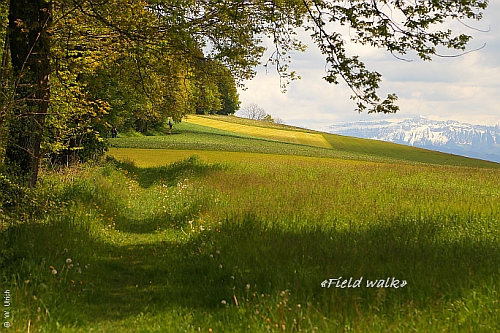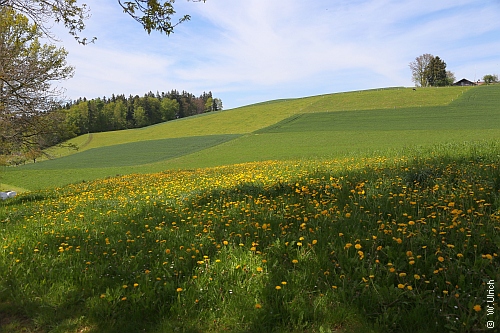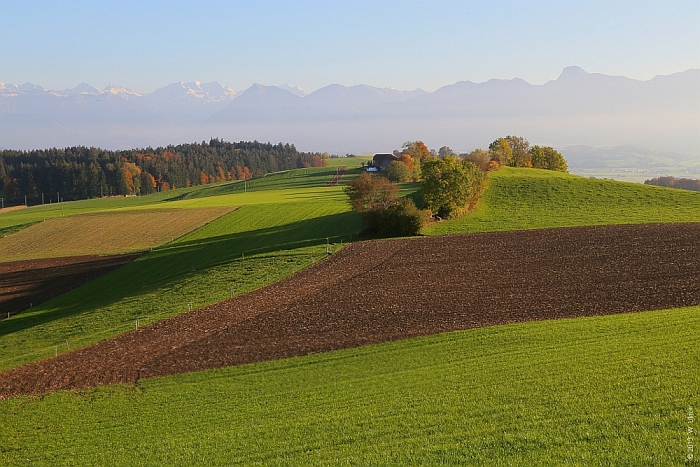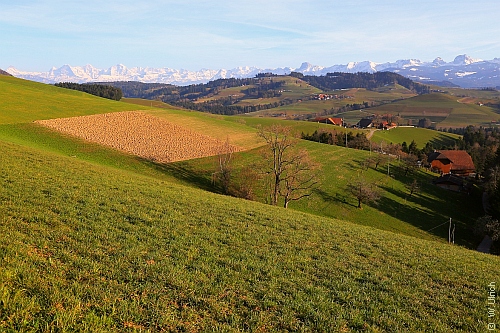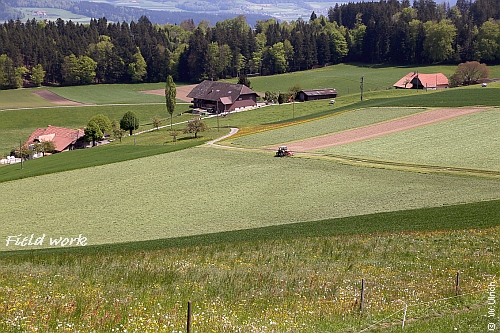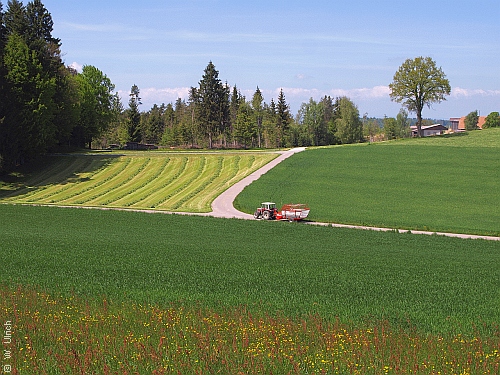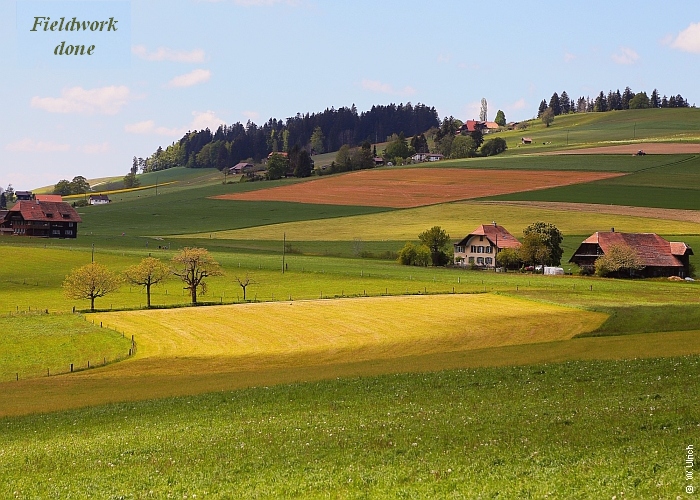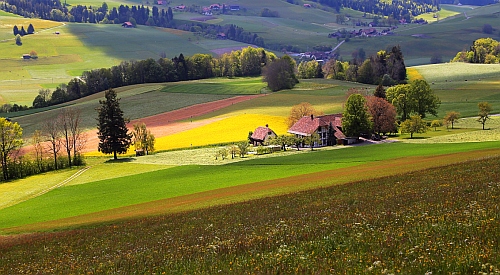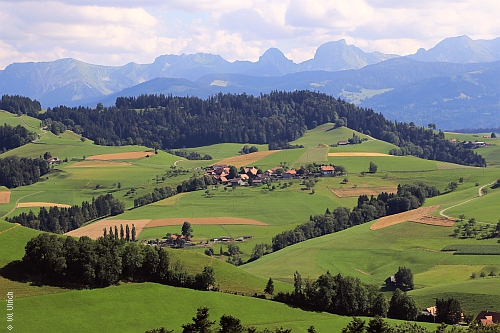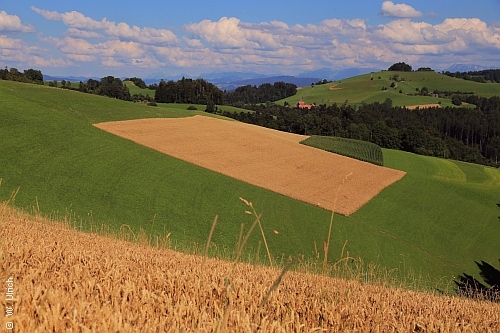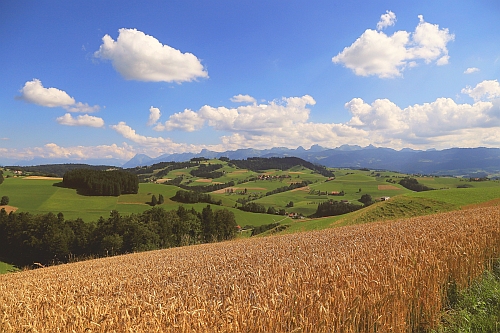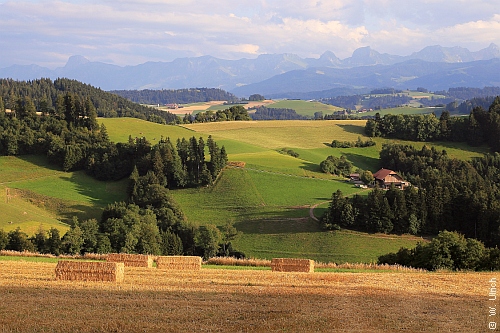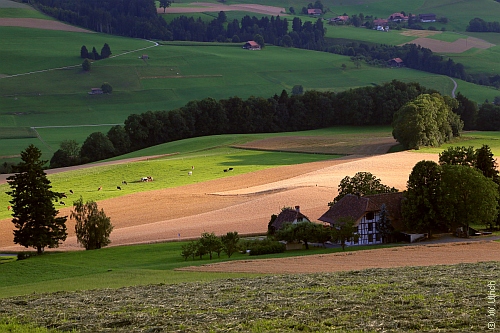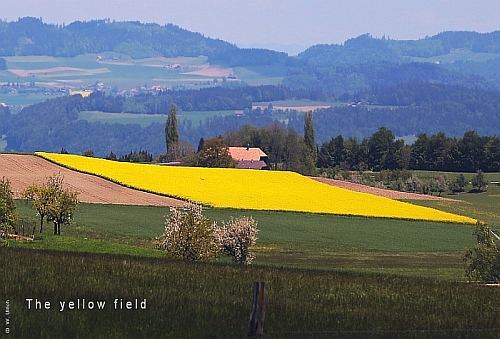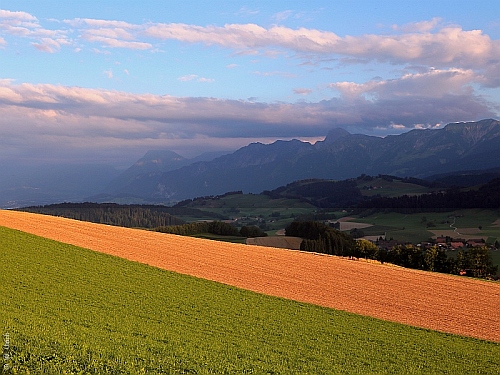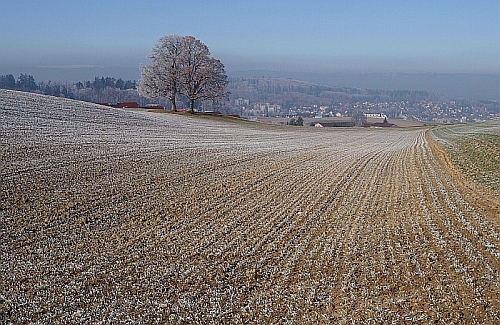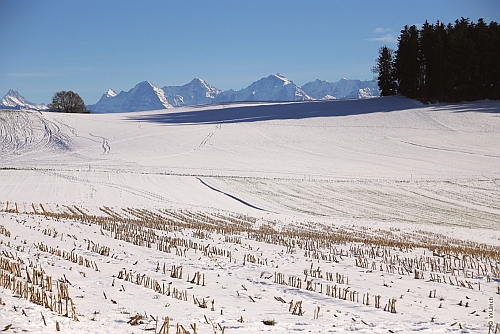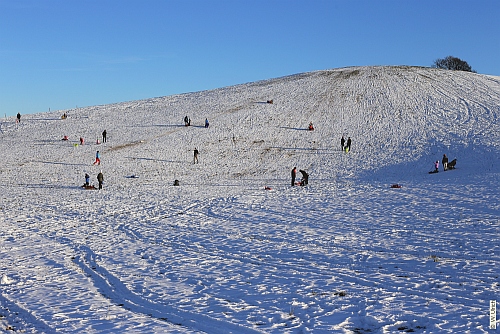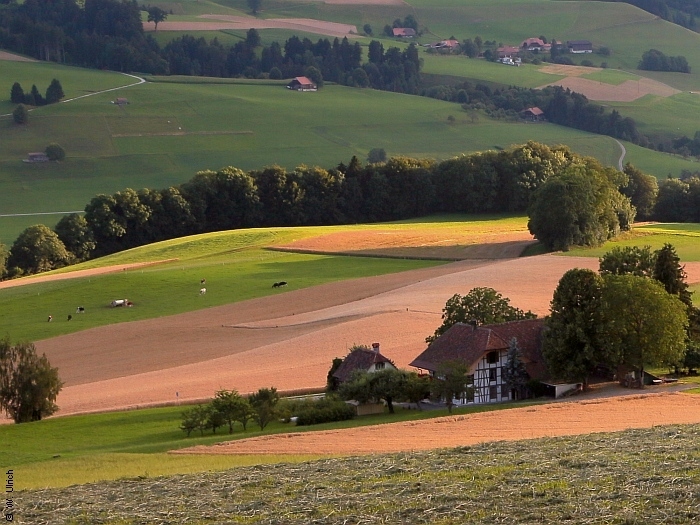Werner Ulrich's Home Page: Ulrich's Bimonthly
Formerly "Picture of the Month"
May-June 2014
Fields

When I take my camera for a walk, it is often not just to be prepared for that one-of-a-kind photographic subject that I might otherwise miss. Rather, I like to walk with a selected photographic theme in mind, depending on the weather, my mood, and the location. Examples would be "seasons," "flowers & trees," "landscapes & locations"; "country houses & churches," "bridges," "medieval towns," "urban photography," "Art Nouveau & Art Deco," "art in the city" or, as my regular readers know, "clouds." Increasingly I have also turned to more abstract themes such as "traces in the snow," "patterns & colors," "reflections," "fields," "metalevelling," and "X in Y." The latter two themes would call for explanations, but this will be for another time. In the present Bimonthly, I want to talk a bit about my current photographic interest in "fields" and the way it is closely connected with my professional and philosophical interests.
I have hinted at the theme in my last Bimonthly's "Variation on a Spring Theme" (Ulrich, 2014). There I used "snow fields" as a photographic theme for early spring pictures, without pointing out though that "fields" are a theme of broader interest to me. As a photographic interest, I mean something more specific than the general notion of field photography, which encompasses all photographic practices other than studio photography. In comparison, my notion of "field" photography is narrower in that I practice it mainly (though not exclusively) in landscape photography; at the same time, however, it is also wider in that it entails for me an abstract and metaphoric side. I associate with it both a specific aesthetic dimension (an observational discipline, as it were) and a specific philosophical dimension (an academic and professional interest).
"Field aesthetics" in landscape photography My photographic heart beats for landscape photography. To be sure, I also appreciate many other photographic topics, among them those enumerated above as some of my current photographic themes. However, landscape photography has a particular aesthetic appeal to me. I have always felt a deep sense of appreciation for beautiful landscapes, perhaps more so than most people I know. A beautiful landscape has something magic for me. It touches my heart. It radiates tranquility and peace to me and invites reflection. It offers moments of deep relaxation and detachment. The photographic theme of "fields" has something to do with this sense of appreciation, although I find it difficult now to tell what was first, my appreciation of landscapes or my photographic interest in them (I suspect the two interests reinforce one another). What I can tell is that the photographic theme of "fields" has stimulated my sense of appreciation for landscapes even more. It has taught me to see landscapes in new ways, which in turn has changed the ways I try to photograph them. But then, in a sense, things have also been the other way round – once I started to see and appreciate fields in landscapes, I became naturally interested in "fields" as a photographic subject. I soon discovered that for landscape photography, it is very often useful to look at landscapes as field compositions in a quite literal sense of the term – arrangements of visual fields of different shape and size, color and saturation, texture and material, light reflection, function, boundaries, and so on. The aesthetics of landscape photography then becomes, inter alia, a question of skilled composition of fields.
But again, to achieve aesthetic compositions of fields, one must first attend to them, that is, consciously look out for them and enjoy them, perhaps love them. In short, one must learn to really see them; and one way to do that is by photographing them. Making them a subject of photographic interest obliges us to pay attention to them, and thereby to gradually also develop an interest in them, discover their almost unlimited diversity, and appreciate their inherent beauty as well as the role they play for the beauty of landscapes.
Remember the old dictum, according to which we only see (discover, perceive, appreciate, etc.) what we are prepared in our minds to consciously and carefully observe. In the terms I have used elsewhere, drawing on Christopher Alexander's (1979) work, we might think of the basic observational skill in question as one of learning to understand a particular pattern language (cf. Ulrich, 2006a). Conceiving of landscapes in terms of fields can indeed teach us seeing landscapes more attentively, at least it has had this effect on me. A new personal sense of landscape aesthetics has thus emerged in my experience of landscapes. It's a rewarding theme and what is more, one of unending appeal, as "fields" abound in virtually every landscape, in any season. This holds true even for landscapes that at first sight may appear relatively monotonous and unstructured, such as a flat landscape covered by snow or a desert landscape with endless sand dunes. The theme of fields certainly is a source of enjoyment whenever I go for a walk in the prealpine countryside in which I live.
Clouds and trees have played a similar role in the development of my interest in landscapes and landscape photography. So have traces of human culture and activity such as a farm house or a church or a small village situated nicely in the landscape; a farmer working on a field with his tractor; a couple of hikers or bikers enjoying it; or a road that snakes its way up a mountain pass. But fields now play a particularly elementary and powerful part in my perception of landscapes, matched only by the part trees and clouds play. Fields provide a most basic type of terrestrial pattern to landscapes (much more basic, for example, than mountains or lakes, which are not present in all landscapes); trees are their biological counterparts and clouds their celestial siblings.
Trees, clouds, and fields: perhaps the basic trinity of a pattern language for seeing and photographing landscapes. In my childhood, one of the games we played was tree spotting (I have described this in my earlier "November walk" Bimonthly, see Ulrich, 2007). Later in my life – much later – I became a cloud spotter (see the Bimonthly page on a "cloudspotter's summer break," Ulrich, 2009). So now it appears I have also become a field spotter. But of course, the term is a bit misleading in that we have already understood that fields are not just there to be "spotted." Rather, we actively construct them in the acts of seeing them and of capturing them photographically. Capturing them photographically remains a constant photographic challenge – a challenge of finding new ways to capture familiar landscapes, as well as new landscapes that illustrate the theme and keep it interesting. The same challenge holds true for trees and clouds. My interest in landscapes (their inherent beauty, including trees, clouds, and fields) and my interest in landscape photography (its compositional, constructive side) have thus become almost inseparable. More and more I realize that the landscape I see is me. The pattern that constitutes the landscape I see happens (or doesn't) in my mind. I compose it, I decide about its aesthetics. The challenge is to observe well so as to achieve a careful composition. It's a necessary effort, for careless compositions have little worth. Chance often helps but even so, it is not a reliable guide, nor is it an art that we can cultivate.
The art of observation, unlike mere chance, lends itself to systematic pursuit and cultivation. In my experience, landscape photography in terms of "fields" can indeed teach us not only to compose more satisfactory landscape photographs but also, and in the first place, to become more careful and engaged observers of the world. The quest for cultivated observation thus takes us beyond photography and enriches our lives quite generally. Moreover, it can add to our professional skills, which brings us to the second of the two dimensions mentioned at the outset.
"Philosophical field work" Cultivated observation is certainly helpful in research and professional practice, as well as in many other fields of human endeavor such as art, design, teaching, health care and other kinds of services, politics, management, commerce, and everyday practice. The preceding, brief account of my interest in the photographic and aesthetic theme of "fields" in landscapes would be seriously incomplete without a hint at my professional interest in it. This is where the philosophical dimension comes in.
As my regular readers know, I am philosophically interested in the meaning and support of "good" (i.e., competent, rational, arguable) professional practice. My methodological focus is on the role and proper handling of boundary judgments in professional judgment (as well as in everyday judgment, to be sure). This work on critical systems heuristics (CSH) and its central methodological principle and tool of boundary critique is motivated by a conviction that "boundary judgments," whether we are aware of them or not (and very often we are not), shape our understanding of "problem" situations and of how we seek to "improve" them. In case you visit this site for the first time and wish you had available a brief first introduction, you may wish to have a look at the two "Mini-Primers" available in this site on critical systems heuristics (CSH) and boundary critique (Ulrich, 2005a and b).
My professional interest in boundary judgments and my photographic interest in landscapes unexpectedly met and became friends precisely ten years ago, in May 2004, when together with my wife and a befriended couple I found myself flying over the French countryside in a small Piper PA-28 "Cherokee" Arrow III plane. As I observed the colorful spring landscape below us and started to take pictures, I suddenly realized that I was engaged in an exercise of boundary judgment: what picture I took depended on the boundary judgments in terms of which I identified interesting "field" patterns in the landscape! I later reported on this experience in a short reflection on the art of boundary crossing (see Ulrich, 2006b).
I suggest you take a brief look at that earlier reflection, it may be the quickest and easiest way to capture the special kind of "fieldwork" that I advocate here. I say "look" rather than "read" since a good way to quickly capture its message may be by starting with its main picture, at the bottom of the page, titled "Spring is in the air, or the art of boundary crossing." Roll your mouse over the picture or, if you use a tablet computer, tap your fingers on the picture, and you'll see immediately what I am talking about. This picture probably represents the conscious origin of the theme of fields in my landscape photography, although I suspect the theme had been present in my photographs long before I conciously appreciated its role.
With hindsight though, it was in May 2004 when the theme of "fields" first emerged consciously in my mind as a way to conceive both of boundary critique and of landscape photography. Beginning with that Piper flight of exactly ten years ago, landscape photography gained a new and deeper, metaphoric dimension for me. In addition to the observational skills and the deepened sense of aesthetics that the fields theme has since helped me to train, landscape photography became related to my philosophical and professional interest in boundary judgments and their conscious and careful handling, that is, in boundary reflection and discourse or what I call boundary critique. Whenever I take my camera for a walk out in the countryside, I am now also engaged in a kind of "field experiment" – I am scanning the nature around me for different "field compositions." It's a constant training in keeping my boundary judgments fluid, as it were.
As a practicing researcher, it was for many years my daily bread to work with empirical data so as to find out what they tell us about the world around us. I am no longer doing empirical work now, as my focus of interest has shifted to the philosophical and methodological ideas that could guide good research practice and professional intervention; yet I suddenly realize I am still engaged in a kind of field research, although it is a rather different kind of field research. Thanks to the theme of "fields" and my corresponding interest in "field photography," landscape photography has, as it were, become my daily fieldwork – a daily training in the art of boundary judgments.
"Field pictures" Here, then, is a selection of "field pictures": variations on a photographic and professional theme.
|
|
For a hyperlinked overview of all issues
of "Ulrich's Bimonthly" and the previous "Picture of the
Month" series,
see the site map
Green and brown fields
Fieldwork
Mixed bags
Summer fields
Red and yellow fields
Winter fields
References
Alexander, C. (1979). The Timeless Way of Building. New York: Oxford University Press.
Ulrich, W. (2005a). A mini-primer of critical systems heuristics. Rev. version of "Critical systems heuristics," in H.G. Daellenbach and R.L. Flood (eds.), The Informed Student Guide to Management Science, London: Thomson Learning, 2002, p. 72f. Werner Ulrich's Home Page, Section on Critical Systems Heuristics (CSH), first published 17 October 2005, http://wulrich.com/csh.html.
Ulrich, W. (2005b). A mini-primer of boundary critique. Rev. version of "Boundary critique," in H.G. Daellenbach and R.L. Flood (eds.), The Informed Student Guide to Management Science, London: Thomson Learning, 2002, p. 41f. Werner Ulrich's Home Page, Section on Critical Systems Heuristics (CSH), first published 17 October 2005, http://wulrich.com/boundary_critique.html.
Ulrich,
W. (2006a). The art of observation: understanding pattern languages.
A review of Christopher
Alexander’s "The Timeless Way of Building" (New York, Oxford University
Press, 1979). Journal of Research
Practice, 2, No. 1, 2006,
article R1 (first published 2 March 2006), http://jrp.icaap.org/index.php/jrp/article/view/26/46.
Ulrich,
W. (2006b). The
art of boundary crossing: another introduction to boundary critique. Ulrich's Bimonthly (formerly Picture of the Month), May 2006, first published 1 May 2006,
http://wulrich.com/picture_may2006.html.
Ulrich,
W. (2007). November walk (late autumn song) [with a paragraph on
tree spotting]. Ulrich's
Bimonthly, November-December 2007, first published 1 November 2007, http://wulrich.com/bimonthly_november2007.html.
Ulrich,
W. (2009). Reading Habermas in the garden chair
(cloudspotter's
summer break). Ulrich's
Bimonthly, July-August 2009, first published 9 July 2009, http://wulrich.com/bimonthly_july2009.html.
Ulrich,
W. (2014). Signs of
thaw: variation on a spring theme. Ulrich's Bimonthly,
March-April 2014, first published 22 March 2014,
http://wulrich.com/bimonthly_march2014.html.
|
May 2014 | |||||||||||||||||||||||||||||||||||||||||||||||||
|---|---|---|---|---|---|---|---|---|---|---|---|---|---|---|---|---|---|---|---|---|---|---|---|---|---|---|---|---|---|---|---|---|---|---|---|---|---|---|---|---|---|---|---|---|---|---|---|---|---|
|
|
June 2014 |
|||||||||||||||||||||||||||||||||||||||||||||||||
|---|---|---|---|---|---|---|---|---|---|---|---|---|---|---|---|---|---|---|---|---|---|---|---|---|---|---|---|---|---|---|---|---|---|---|---|---|---|---|---|---|---|---|---|---|---|---|---|---|---|
|
Picture data (for the Bimonthly picture below): Digital photograph taken on 11 August 2013, around 7:30 p.m., near Rüeggisberg, Bern, Switzerland. ISO 200, exposure mode aperture priority, aperture f/14.0, exposure time 1/50 seconds, exposure bias -0.33; metering mode center-weighted average, contrast normal, saturation high, sharpness high. Focal length 148 mm (full frame), equivalent to 148 mm with a conventional 35 mm camera. Original resolution 5472 x 3648 pixels; current resolution 700 x 475 pixels, compressed to 240 KB.
May-June, 2014
| The red field |
„Fieldwork”
Notepad for capturing personal thoughts »
|
Personal notes:
Write
down your thoughts before
you forget them! |
|
Last
updated 27 May 2014 (first published 23 May 2014)
http://wulrich.com/bimonthly_may2014.html
